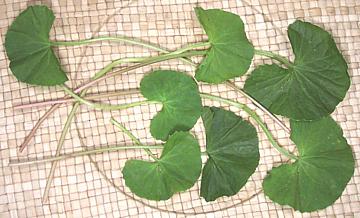 [Gotu kola (Sri Lanka); Dollarwort (U.S.);
Rau-ma (Viet); Myin-kwa-ywet (Burma); Pegaga (Malay); Buabok (Thai);
Pegagan (Indonesia); Takip-kohol (Philippine); Hydrocotyle or
Centella asiatica (small variety) H. or C. javanica
(larger variety)]
[Gotu kola (Sri Lanka); Dollarwort (U.S.);
Rau-ma (Viet); Myin-kwa-ywet (Burma); Pegaga (Malay); Buabok (Thai);
Pegagan (Indonesia); Takip-kohol (Philippine); Hydrocotyle or
Centella asiatica (small variety) H. or C. javanica
(larger variety)]
Pennyworts grow worldwide in wet and moist tropical and temperate areas but the varieties of most culinary interest are native to Southeast Asia, Sri Lanka and Australia. Botanists variously place them in family Apiaceae with carrots and parsley or in family Araliaceae with ginseng or in family Mackinlayaceae with a few Australian plants of little note. The largest photo specimen (C. javanica) is 3-1/2 inches across the leaf.
Non-Asian species have fully round leaves with the stem attached near the middle of the underside. Water Pennywort (Hydrocotyle ranunculoides) is native to North and South America and grows in water with the leaves floating on the surface. Hydrocotyle vulgaris looks like ranunculoides but grows out of water, is native to North Africa, Europe and Florida, and the variety noted in English and European herbals. All common species are edible.
More on Parsleys and Aralias.
Pennywort is found in markets serving Vietnamese communities. It is generally sold in bags weighing about 1 pound labeled Rau-Ma, Pennywort or both. I don't see it often but have purchased it in May and June. See our recipe Pennywort Drink, a very common use for this herb.
Yield: A pound will yield about 4-1/2 ounces of leaves and the rest stems. At $5/pound with stems that four ounces of leaf is pretty costly, so if I make salad from the leaves I use the stems for pennywort drink - not so pretty green as with leaves but better looking and better tasting than the canned stuff.
Medicinally, pennywort has a considerable reputation as a tonic. It is considered a blood purifier and good for eyes, nervous conditions, memory and arthritis. It is reported with some medical support that a paste is helpful in healing wounds and reducing scaring. It is also often applied as a facial for a more youthful appearance.
Pennywort is quite perishable and should be kept bagged and refrigerated and used within a couple days of purchase.
py_pennywz 080531 - www.clovegarden.com